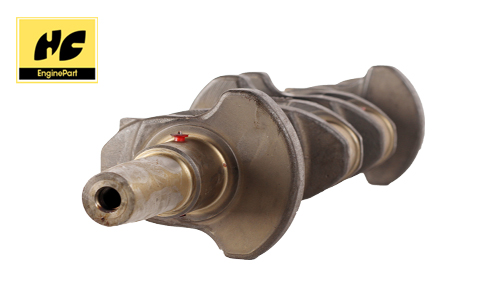Causes of crankshaft bending
2020-09-15
The crankshaft is a key component of the engine, and its performance is directly related to the quality and life of the engine. The quality status of the crankshaft directly determines the operating quality and safety level of the diesel engine. If the crankshaft continues to be used after bending and torsion deformation, it will accelerate the wear of the crankshaft connecting rod mechanism, and even cause cracks and fractures in the crankshaft. Before the engine is assembled, it is found that the curvature of the crankshaft has exceeded the technical standard, so the coaxial bushes should not be reluctantly assembled. If the crankshaft with excessive curvature is fitted with the main bushes, the crankshaft will be tight and loose during operation. The crankshaft will generate an additional pressure on the bearing bush, and as a result, the bearing bush will wear out faster, which may cause a bush burning accident. This article analyzes the cause of crankshaft bending and twisting.

Causes of crankshaft bending and twisting:
(1) When the crankshaft is grinding and processing, the clamping positioning is not proper, and the accuracy of the grinder itself is not high.
(2) The engine is overloaded, continuously "deflagration", and the work is not stable, so that the force of each journal is uneven.
(3) The gap between the crankshaft bearing and the connecting rod bearing is too large, and the tightness is different, which causes the main journal center to not overlap and is impacted during operation.
(4) When the engine's bearing is burnt out and the crankshaft is hugged, the crankshaft will bend and twist.
(5) The crankshaft axial movement is too large, or the weight of the piston and connecting rod group is different, and the difference is too large.
(6) The ignition time is too early, or there are often 1 or 2 spark plugs that work poorly, causing the engine to run unbalanced and the crankshaft to receive uneven force.
(7) The balance of the crankshaft is broken, or the balance of the crankshaft connecting rod group and the flywheel is broken; the crankshaft is excessively worn, insufficient strength and rigidity, or bending and torsion due to improper assembly.
(8) The material of the crankshaft is not good, or the crankshaft is deformed due to unreasonable placement for a long time.
(9) When the car starts driving, the action of loosening the clutch pedal is too fast, and the engagement is not soft. Or start the engine with impulse force, causing the crankshaft to be suddenly twisted.
(10) Use emergency braking while driving, or use high gear and low speed to reluctantly drive when the engine power is insufficient.